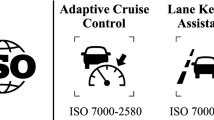Abstract
Driving performance was measured using the lane change test (LCT). Participants followed lane change instructions presented in three locations: road signs, a head-up display (HUD), and a head-down display (HDD). To measure the participants’ ability to detect ecologically-valid stimuli while viewing the displays, a peripheral detection task (PDT) with inward-moving stimuli from either side of the road was applied on half of tracks. Interacting with the HDD resulted in the poorest driving performance, and similar driving performance was found with the road signs and the HUD. Further analyses revealed that the participants’ age had an effect on their performance with the display locations. The younger age group (20–24 years) drove the best with the HUD; while the older age group (26–31 years) drove the best with the road signs. PDT performance differences were not significant. Results indicate that HUDs may be a good option for displaying navigational information to drivers.
Access this chapter
Tax calculation will be finalised at checkout
Purchases are for personal use only
Similar content being viewed by others
References
Demographics of Mobile Device Ownership and Adoption in the United States (2018). http://www.pewinternet.org/fact-sheet/mobile/
Currin, A.: U drive. U text. U pay. In: U.S. Department of Transportation, National Highway Traffic Safety Administration. (2018)
Norman, D.A., Bobrow, D.G.: On data-limited and resource-limited processes. Cogn. Psychol. 7, 44–64 (1975)
Fernandez-Duque, D., Johnson, M.L.: Cause and effect theories of attention: the role of conceptual metaphors. In: Review of General Psychology, pp. 153–165 (2002)
Haj-Assaad, S.: 8 car features that will soon be obsolete. In: AutoGuide.com News. https://www.autoguide.com/autonews/2016/05/8-car-featuresthat-will-soon-be-obsolete.html
Estrada, M.: Mpow’s $30 HUD has more features than the head-up display in a $100,000 Mercedes. https://bgr.com/2017/06/06/smartphone-hudcarprojector-amazon-iphone-android/
Inuzuka, Y., Osumi, Y., Shinkai, H.: Visibility of head up display (HUD) for automobiles. In: Proceedings of the Human Factors and Ergonomics Society Annual Meeting, pp. 1574–1578 (1991)
Liu, Y., Wen, M.: Comparison of head-up display (HUD) vs. head-down display (HDD): driving performance of commercial vehicle operators in Taiwan. Int. J. Hum.-Comput. Stud. 61, 679–697 (2004)
Biberman, L.M., Alluisi, E.A.: Pilot errors involving head-up displays, helmet-mounted displays, and night vision goggles. Institute for Defense Analyses, Alexandria, Virginia (1992)
Horberry, T., Anderson, J., Regan, M., Triggs, T., Brown, J.: Driver distraction: the effects of concurrent in-vehicle tasks, road environment complexity and age on driving performance. In: Accident Analysis & Prevention, pp. 185–191 (2006)
International Organization for Standardization: Road vehicles – Ergonomic aspects of transportation information and control systems – Simulated lane change test to assess in-vehicle secondary task demand (ISO/DIS Standard No. 26022), Geneva, Switzerland (2010)
Harbluk, J.L., Burns, P.C., Lochner, M., Trbovich, P.L.: Using the lane change test (LCT) to assess distraction: tests of visual-manual and speech-based operation of navigation system interfaces. In: Proceedings of the 4th International Driving Symposium on Human Factors in Driver Assessment, Training, and Vehicle (2007)
Hada, H.: Drivers’ visual attention to in-vehicle displays: effects of display location and road type. Technical report, The University of Michigan, Transportation Research Institute, Ann Arbor (1994)
Tretton, P., Garlin, A., Nilsson, R., Larsson, T.: An on-road study of head-up display: preferred location and acceptance levels. In: Proceedings of the Human Factors and Ergonomics Society Annual Meeting, pp. 1914–1918 (2011)
Olsson, S., Burns, P.C.: Measuring driver visual distraction with a peripheral detection task. Volvo Technological Development Corporation, Gothenburg, Sweden (2000)
Burnett, G.E.: A road-based evaluation of a head-up display for presenting navigation information. In: Proceedings of HCI International Conference, pp. 180–184 (2003)
Moran, S.N.: Performance and attentional abilities of automobile drivers with head-up and head-down displays (Master’s thesis). California State University, Long Beach (2018)
Author information
Authors and Affiliations
Corresponding author
Editor information
Editors and Affiliations
Rights and permissions
Copyright information
© 2020 Springer Nature Switzerland AG
About this paper
Cite this paper
Moran, S.N., Strybel, T.Z., Hancock, G.M., Vu, KP.L. (2020). Using the Lane Change Test to Investigate In-Vehicle Display Placements. In: Stanton, N. (eds) Advances in Human Factors of Transportation. AHFE 2019. Advances in Intelligent Systems and Computing, vol 964. Springer, Cham. https://doi.org/10.1007/978-3-030-20503-4_54
Download citation
DOI: https://doi.org/10.1007/978-3-030-20503-4_54
Published:
Publisher Name: Springer, Cham
Print ISBN: 978-3-030-20502-7
Online ISBN: 978-3-030-20503-4
eBook Packages: EngineeringEngineering (R0)




